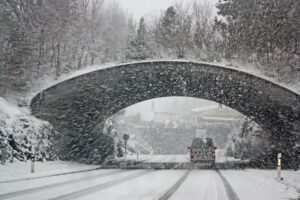
The first significant winter storm of the 2025-2026 winter weather season appears to be taking shape, with computer models suggesting the likely development of a storm in the northeast this coming Tuesday and Wednesday. While some computer models have been forecasting the possibility of a storm, it was only today that most of the global models came into solid agreement that a storm would form.
While the models are aligned with the concept of the storm and how it will evolve, the devils remain in the details, with subtle differences in each model suggesting significantly different things, especially around the highly populated I-95 corridor between Washington, DC and Boston, including Philadelphia and New York. It is still too soon to say which model solution is the most correct and as a result it is also too soon to say where the rain / snow line will set-up.
The GFS and ECMWF are among many computer models meteorologists use to assist in weather forecasting. While meteorologists have many tools at their disposal to create weather forecasts, two primary global forecast models they do use are the ECMWF from Europe and the GFS from the United States. While the models share a lot of the same initial data, they differ with how they digest that data and compute possible outcomes. One is better than the other in some scenarios, while the opposite is true in others. No model is “right” all the time. Beyond the ECMWF and GFS models, there are numerous other models from other countries, other academic institutions, and private industry that are also considered when making a forecast.

Currently a majority of the global models reflect a developing low pressure east of New Jersey, with some centering the system more north or south, or closer or farther from land. Due to those differences, some models bring snow into the I-95 corridor while others keep it well north.
In general, when looking at the overall pattern and global forecast model output, it appears high pressure will retreat a bit northeast as the low pressure system approaches from the south. If this happens, it will favor onshore flow and marine influence affecting temperature profiles for many, especially those in and south of the I-95 corridor. Initially, snow or a rain and snow mix could be possible as far south as the I-95 corridor, with all snow favored northwest of the fall line, and all rain favored to the southeast of I-95. Through the day Tuesday, the rain snow line will likely shift northwest. At the peak of precipitation coverage and intensity, all snow is possible for the Poconos and into adjacent portions of far northwestern NJ, a rain snow mix will be favored northwest of the fall line, and all rain elsewhere.
If the high pressure is stronger than what it is forecast now, or if the coastal storm path shifts a bit, it could hold colder air closer to the coast, bringing accumulating snow not only to the I-95 corridor for Washington DC and north, but could also produce accumulating snow for portions of the Jersey Shore and Long Island.
North of I-95 into interior New England, snow could be heavy and accumulate in excess of 6-12″. The same factors that will influence what will happen in the I-95 corridor will also determine how much snow falls on the northern side of the storm.
As forecast models ingest more data and meteorologists review more data being captured by weather satellites, weather balloons, and ground stations, the forecast will be further refined.
This Tuesday/Wednesday storm will also help set the stage for what happens with another storm around the 9th-11th. This second storm has the potential for dumping another round of heavy snow, possibly even more south than the Tuesday/Wednesday system.